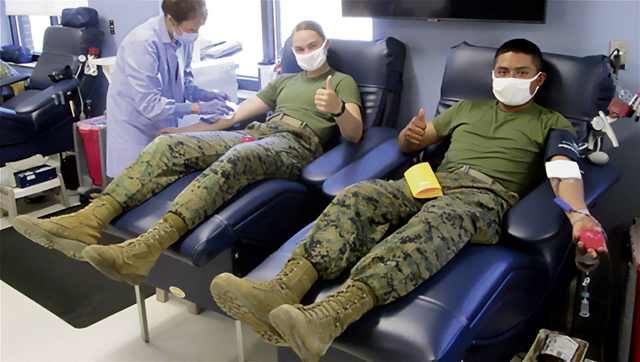
In recognition of National Blood Donor month in January, the Armed Services Blood Program reminds the military community about the importance of donating blood.
“Blood is a critical tool to save lives and the need for blood is constant, from the patient undergoing emergency surgery to the person receiving treatment at a military treatment facility to our warfighters far forward,” said ASBP Division Chief Navy Capt. Leslie Riggs. “A steady and ready supply of quality blood products will always be needed.”
Riggs noted that during the holidays and winter months, the number of donations often decrease, with things like vacations, illnesses, and weather changes hindering people from giving blood. “The military health care system needs many units of blood every day. The ASBP has a mission to meet that need globally, whenever, and wherever needed,” Riggs said.
When the need arises, the ASBP will coordinate additional blood donation events, including large-scale blood drives that elevate the message of the importance of donating blood.
“An adage within the industry is ‘the most-needed type is the one not on the shelf’; fully stocked and ready supply is ultimately what is needed and always the ASBP goal, regardless of type,” explained Riggs.
He added that donors with Type O blood are considered ‘universal blood donors’ while those with Type AB are considered ‘universal donors’ for platelet donations. These donations can be used for any type of recipient in certain situations, or when treatment facilities are low on other blood types.
Established over 70 years ago as the official blood program of the U.S. military, “the ASBP focuses on equipping the warfighter with lifesaving blood products needed on the battlefield as well as in military treatment facilities. The ASBP mission is to provide quality blood products and support for military health care operations worldwide,” Riggs said.
Besides collecting donations, the ASBP also tests, stores, transports and distributes blood worldwide. There are over 20 ASBP blood donor centers stateside and overseas. Each of the services operates multiple blood donor centers, with many donor centers traveling to conduct mobile drives in their surrounding areas or further out for large-scale blood drives.
While ASBP blood recipients are most often thought of as service members injured in the line of duty, the ASBP also provides blood for service members and their families back home and in military hospitals and clinics around the globe.
According to Riggs, tens of thousands of individuals donate blood to the ASBP each year, many of whom are repeat donors. Despite the intention of wanting to donate blood, sometimes an individual can be deferred for several reasons, but they can often help in other ways.
“There are several ways to help save lives with the ASBP, even if you are ineligible to donate at this time,” said Riggs, adding that if an individual is ineligible, they can check back later. “Most deferrals are often temporary and have set timeframes.”
“You can also help coordinate a drive with your unit or military community group or volunteer at an ASBP blood drive near you. You can also help spread the word about the program and our mission, and encourage others to donate by engaging and following the ASBP on its social media channels: Facebook: @militaryblood, twitter: @militaryblood, and Instagram: @usmilitaryblood,” Riggs said.
The ASBP is one of four organizations, including the American Red Cross, America’s Blood Centers, and the Blood Centers of America, that ensure the nation has a safe and potent blood supply. The four agencies collaborate in times of need and during emergencies. “We work together during humanitarian efforts, on emergency task forces, and other connections,” said Riggs. “However, the ASBP is the official and only blood program of the military, and it is not affiliated with other civilian collection agencies.”
If a service or family member is interested in learning more about or donating blood, Riggs suggested they visit the ASBP website at https://www.militaryblood.dod.mil/.


